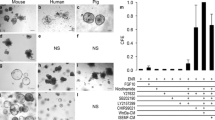Abstract
Enterocytes at the tips of microvilli are more sensitive to an ischemic insult than those cells residing in the crypts, an effect thought to be due to a relative lack of collateral flow. We speculated that this increased cellular sensitivity to ischemia might be an intrinsic feature of the cells related to their differentiated phenotype. To test this hypothesis, enterocyte response to ischemia was determined using both in vivo and in vitro models. For the in vivo studies, male Sprague-Dawley rats underwent laparotomy, and small intestinal ischemia was induced by clamping the superior mesenteric artery for 30 or 60 minutes, after which reperfusion was allowed for various time points up to 4 days. Injury was assessed histologically, as well as with Northern blots, probing for the enterocyte differentiation markers intestinal alkaline phosphatase and lactase, as well as the gut-epithelial marker villin. Mucosal changes consistent with ischemia/reperfusion injury were evident—that is, a rapid inflammatory response followed by progressive villus cell loss beginning at the tips and progressing to the crypts, depending on the degree of insult, with an eventual return to normal microanatomy. Intestinal alkaline phosphatase and lactase were lost immediately after ischemia and returned with reperfusion, confirming that the differentiated cells are particularly sensitive to ischemic injury. The in vitro studies employed two separate models of enterocyte differentiation: sodium butyrate-treated HT-29 cells and Caco-2 cells maintained for 7 days after confluence. In both models, undifferentiated and differentiated cells were subjected to treatment with 2-deoxyglucose and oligomycin-A (in vitro model of ischemia) and apoptosis was assessed by fluorescence-activated cell sorting analysis. Differentiation of both cell lines resulted in a significantly greater apoptotic response to ischemia compared to undifferentiated cells exposed to an identical insult. We conclude that differentiated enterocytes may be inherently more sensitive to ischemia-induced injury than their undifferentiated counterparts. These findings call into question the popularly held belief that villus tip cells are more susceptible to ischemia because of their location relative to the microvascular anatomy.
Similar content being viewed by others
References
Potten CS. Epithelial cell growth and differentiation. II. Intestinal apoptosis. Am J Physiol 1997;273:253–257.
Gordon JI, Schmidt GH, Roth KA. Studies of intestinal stem cells using normal, chimeric and transgenic mice. FASEBJ 1992;6:3039–3050.
Traber PG. Diferentiation of intestinal epithelial cells: Lessons from the study of intestine-specific gene expression. J Lab ClinMed 1994;123:467–477.
Cheng H, Leblond CP. Origin, differentiation and renewal of the four main epithelial cell types in the mouse small intestine. V. Unitarian theory of the origin of the four epithelial cell types. AmJ Anat 1974;141:537–562.
Gavriele Y, Sherman Y, Ben-Sasson SA. Identification of programmed cell death in-situ via specific labeling of nuclear DNA fragmentation. J Cell Biol 1992;119:493–501.
Gordon JI. Intestinal epithelial differentiation: New insights from chimeric and transgenic mice. J Cell Biol 1989; 108:1187–1194.
Williamson RC. Intestinal adaptation (first of two parts). Structural, functional and cytokinetic changes. N Engl J Med 1978;298:1393–1402.
Williamson RC. Intestinal adaptation (second of two parts). Mechanisms of control. N Engl J Med 1978;298:1444–1450.
Mitsudo S, Brandt LJ. Pathology of intestinal ischemia. Surg Clin North Am 1992;72:43–63.
Robinson JW, Mirkovitch V, Winistorfer B, Saegesser F. Response of the intestinal mucosa to ischemia. Gut 1981; 22:512–27.
Kampp M, Nilsson NJ. Extravascular shunting of oxygen in the small intestine of the cat. Acta Physiol Scand 1968;72:396–403.
Noda T, Iwarkiri R, Fujimoto K, Matsuo S, Aw JY. Programmed cell death induced by ischemia-reperfusion in rat intestinal small mucosa. Am J Physiol Gastrointest Liver Physiol 1998;274:270–276.
Ikeda H, Suzuki Y, Suzuki M, Koike M, Tamura J, Tong J, Nomura M, Itoh G. Apoptosis is a major mode of cell death caused by ischaemia and ischaemia/reperfusion injury to the rat intestinal epithelium. Gut 1998;42:530–537.
Sha KA, Green CJ. Characterization of apoptosis in intestinal ischaemia-reperfusion injury—a light and electron microscopic study. IntJ Exp Path 1997;78:355–363.
Chirgwin JM, Przybla AE, MacDonald RJ, Rutter WJ. Isolation of biologically active ribonucleic acid from sources enriched in ribonuclease. Biochemistry 1979;18:5294–5299.
Feinberg AP, Vogelstein B. A technique for radiolabeling DNA restriction endonuclease fragments to high specific activity. Anal Bioch 1983; 132:6–13.
Henthorn PS, Raducha M, Edwards YH, Weiss MJ, Slaughter C, Lafferty MA, Harris H. Nucleotide and amino acid sequences of human intestinal alkaline phosphatase: Close homology to placental alkaline phosphatase. Proc Natl Acad Sci USA 1987;84:1234–1238.
Pringault E, Arpin M, Garcia A, Finidori J, Louvard D. A human villin cDNA clone to investigate the differentiation of intestinal and kidney cells in vivo and in culture. EMBO J 1986;5:3119–3124.
Buller HA, Kothe MJC, Goldman DA, Grubman SA, Sasak WV, Matsudaira PT, Montgomery RK, Grand RJ. Coordinate expression of lactate-phlorizin hydrolase mRNA and enzyme levels in rat intestine during development. J Biol Chem 1990;265:6978–6983.
Cleveland DW, Lopata MA, McDonald RJ, Conan NJ, Rutter WJ, Kirschner MW. Number and evolutionary conservation of α- and β-tubulin and cytoplasmic β- and γ-actin genes using specific cloned cDNA probes. Cell 1980;20:95–105.
Matthews JB, Smith JA, Tally KJ, Menconi MJ, Nguyen H, Fink MP. Chemical hypoxia increases junctional permeability and activates electrogenic ion transport in human epithelial monolayers. Surgery 1994;116:150–157.
Hodin RA, Meng S, Archer S, Tang R. Cellular growth state differentially regulates enterocyte gene expression in butryate-treated HT-29 cells. Cell Growth Diff 1996;7:647–653.
Pinto M, Robine-Leon S, Appay M, Kedinger M, Triadou N, Dussaulx E, Laeroix B, Simon-Assmann P, Maffen K, Fogh J, Zweibaum A. Enterocyte-like differentiation and polarization of the human colon carcinoma cell line Caco-2 in culture. Biol Cell 1983;47:323–330.
Author information
Authors and Affiliations
Corresponding author
Additional information
Supported by grants DK47186, DK02527, and DK50623 from the National Institutes of Health.
Rights and permissions
About this article
Cite this article
Hinnebusch, B.F., Ma, Q., Henderson, J.W. et al. Enterocyte response to ischemia is dependent on differentiation state. J Gastrointest Surg 6, 403–409 (2002). https://doi.org/10.1016/S1091-255X(01)00076-2
Issue Date:
DOI: https://doi.org/10.1016/S1091-255X(01)00076-2




